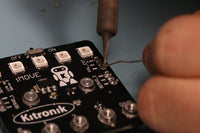



Buy locally from a partner
Bundled options
Kitronik Heat Activated Switch plus wire cutters
 +
+

Kitronik Heat Activated Switch plus wire cutters and soldering starter kit
 +
+
 +
+

Description
Same Day Dispatch
- Orders placed online before 3:00pm Monday - Friday (excluding public holidays and our Christmas shutdown period) are always dispatched the same day provided the goods are in stock. If the goods are not in stock we will endeavour to contact you as soon as possible to discuss a dispatch date.
UK Deliveries
- If you live on the UK mainland and don't have any large materials or lithium batteries in your order it will cost £3.95 (£4.74 including VAT) if you spend less than £40 (£48 including VAT).
- If you spend between £40 and £200 (£48 - £240.00 including VAT, excluding large materials or lithium batteries) delivery is free to most locations, £12 (£14.40 including VAT, excluding large materials or lithium batteries) to Northern Ireland and £15 (£18.00 including VAT, excluding large materials or lithium batteries) to UK remote locations. For a list of postcodes that will be charged the remote location rate: remote area list.
- If you spend over £200 (£240.00 including VAT, excluding large materials or lithium batteries) delivery is free within the UK.
Rest of the world
- These orders are sent via UPS, and the cost is dependant on the service you choose at checkout. Alternatively you can choose the free collection option and have your own courier collect it from us. International orders can only be shipped to the registered card address. Please note: International orders may be charged import duty dependant on local import laws and duty rates. These charges are usually billed to you directly from UPS.
- Delivery times vary for international orders depending on the service selected and the destination. You can see the delivery time and cost at the shipping stage, or by using the shipping estimator from within the shipping basket.
Collection
- If you would like to collect your order, or use your own courier then there is an option you can select during checkout. We do not charge a packaging or handling fee for this service, and you will receive an email when your order has been processed, you can collect half an hour after receipt of this email.
Further Information
- For information about all of the delivery options we offer see full delivery details.
How to solder - an introductory guide: If you're new to soldering our Soldering School will have you up and running in no time. What is soldering? Soldering is a...
How to solder - an introductory guide: If you're new to soldering our Soldering School will have you up and running in no time. What...
ire being used but it would be somewhere in the hundreds/thousands of feet range. That sounds like it should be workable. I don't know the exact details of the heater and its tolerances for lighting the gas but if you powered the temperature switch kit with 2 D batteries it would output roughly 2V at up to 0.5A which I expect would be plenty for your heater if it is currently running from 1 D battery. (0.9V is lost through the transistor pair on the board.) So you might not need a relay. You could use this relay though http://www.kitronik.co.uk/products/components/relays/5v-relay-single/ but you would need to use 4xAA batteries with the temperature kit to trigger the relay. For your final question I would not recommend using this board to measure a specific voltage, the drop over the darlington pair is about 0.9V which is a massive proportion of the 1.2V your batteries provide. You would be better off using a voltage divider circuit and a single transistor.
Ask a question about this product
Payment & Security
Your payment information is processed securely. We do not store credit card details nor have access to your credit card information.

 This product is designed and manufactured in the UK by Kitronik.
This product is designed and manufactured in the UK by Kitronik.